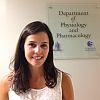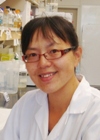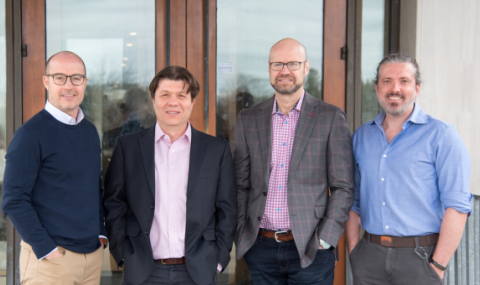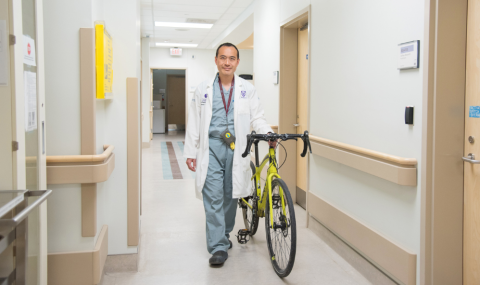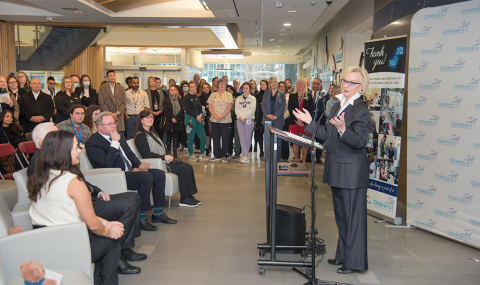Yonathan Araya is a PhD student in the Department of Medical Biophysics, under the supervision of Dr. Timothy Scholl. Yonathan is currently investigating the uptake, penetration, homogeneity, and distribution of serum albumin in breast cancer tumours. The albumin-SPARC (secreted protein acidic and rich in cysteine)-glycoprotein 60 pathway has been shown as a marker for angiogenic blood vessels in breast cancer tumours. Using a novel magnetic resonance field-cycling imaging method, called delta relaxation-enhanced magnetic resonance (dreMR), and the targetable contrast agent Albavar, he proposes to evaluate albumin trafficking to improve the early detection capabilities of aggressive breast cancer phenotypes. dreMR imaging will improve current clinical limitations for protein based MR imaging. |
|
Alexandra Blake is an MSc student working under the supervision of Dr. Moshmi Bhattacharya, in the Department of Physiology and Pharmacology. Her project focuses on determining how the G protein coupled receptor KISS1R, cross talks with growth factor receptors, to regulate breast cancer progression. Using a multidisciplinary approach, she will dissect the mechanisms by which this occurs. This knowledge will improve our understanding of KISS1R as a regulator of breast cancer progression and uncover a potentially new therapeutic target. |
|
| Adrienne Borrie is a PhD student working under the supervision of Dr. Richard Kim, in the Department of Clinical Pharmacology. Clinically important therapy for breast cancer includes a group of drugs called the aromatase inhibitors. These drugs are effective for treating breast cancer, but they may have unwanted effects, such as thinning of the bones or osteoporosis. This project will help scientists understand which genes cause unwanted effects with the hope that we can prevent them. Knowing a patient’s genes and how they break down drugs will help us individualize therapy for each person undergoing breast cancer treatment. |
|
| Natasha Caminsky is an MSc student working under the supervision of Dr. Peter Rogan, in the Department of Biochemistry. Her project concerns patients who have a strong family history of breast and ovarian cancer. She is focusing on those families that have had genetic testing but no mutation was identified that is thought to be the cause their hereditary cancer. They use unique laboratory and computational approaches to analyze the patient's DNA with the hope of identifying a mutation that they think is the underlying cause of the cancer that runs in their family. Their goal is to be able to provide these patients with more information on their disease and make preventative testing in other family members an option |
|
Katelyn Cousteils is an MSc student in the Department of Biochemistry, under the supervision of Dr. Eva Turley. Based on the lab's previous experiments it is expected that fibroblasts expressing RHAMM are associated with greater incidence rates of breast cancer, so Katelyn will identify stromal fibroblasts expressing this, co-culture them with human breast cell lines expressing a fluorescent protein as a marker, and inject these cell mixture into mice, which will then be examined for human cell proliferation. She expects to see that those with the RHAMM-expressing fibroblasts will show increased cell proliferation in the mice, potentially making this a way to identify a high-risk breast cancer group. |
|
Stephanie Dorman is a PhD student in the Department of Biochemistry, under the supervision of Dr. Peter Rogan. Her lab has recently proposed that there is a set of stable genes that are not mutated and remain unchanged in 90% of breast cancer tumours, some of which are targets of routine chemotherapy agents. She hopes to use this stable genes set to identify specific clinical tests that can be used to predict chemotherapy resistance based on the genetics of the breast cancer tumour being treated. Metastatic breast cancer patients have a median survival of approximately 2 years and would greatly benefit from the development of a consistent test and/or guideline to select the chemotherapy agents that will most likely be successful.
|
|
Omar El-Sherif is a PhD student in the Department of Medical Biophysics, under the supervision of Dr. Stewart Gaede. Their work focuses specifically on left-sided breast cancer radiation therapy treatment planning. In the case of left-sided breast cancer radiation treatment, the motion of the heart caused by respiration can lead to significant heart irradiation during treatment. Radiation-induced toxicity of the heart may lead to an increased risk of cardiovascular disease later in a patient's life. Their research goal is to develop radiation therapy treatment plans that incorporate each patient's specific breathing pattern in an attempt to minimize radiation to the heart. |
|
|
|
Jeff Gaudet is an MSc student in the Department of Medical Biophysics, under the supervision of Dr. Paula Foster. I will be working on using MRI to track the effectiveness of using cell-based therapies to generate an immune system response to breast cancer cells. The cells will be tracked using iron nanoparticles in a mouse model. |
Asma Hasan is an MSc student in the Department of Anatomy and Cell Biology, under the supervision of Dr. Peeyush K. Lala. MicroRNAs are small regulatory RNAs which are emerging as biomarkers for cancer. She will be studying the gene target of two COX-2 induced microRNAs, and its role in breast cancer progression and metastasis. |
|
Alexandra Hauser-Kawaguchi is an MSc student in the Department of Chemistry, under the supervision of Dr. Len Luyt. RHAMM is a protein that is known to initiate and promote breast cancer (BCA), and it is one of the biological receptors for Hyaluronan (HA), a carbohydrate that is associated with BCA progression. High expression of the protein is correlated with poor prognostic outcome, metastases, and relapse of the disease. However, little is known about the structure of RHAMM, and how it affects the interactions between the protein and HA. For this reason, we are conducting studies using isothermal titration calorimetry (ITC) to identify the importance of secondary structure in biologically important interactions, and comparing the interactions that peptides of different lengths have with HA. In addition, we are creating a nanoplatform made up of known RHAMM-targeting peptides, and evaluating its ability to target RHAMM using molecular imaging techniques. |
|
Jenna Kara is an MSc student in the Department of Medical Biophysics, under the supervision of Dr. Dwayne Jackson and Dr. Paula Foster. Some patients develop metastases several years after breast cancer remission. Re-activation of dormant cells induced by stress may explain the prolonged period between treatment and relapse in many cases. Previous research from our lab illustrates that neuropeptide Y (NPY), a substance released from nerves during stress, promotes tumour progression. My research seeks to understand the role of the neuropeptide Y (NPY)- neuropeptide Y5 receptor (Y5R) system in cancer recurrence. |
|
Bart Kolendowski is a PhD student working under the supervision of Dr.Torchia at the London Regional Cancer Program and is in the department of Biochemistry at Western University. Bart's work focuses on the estrogen receptor (ER) which is an intracellular steroid hormone receptor that is expressed in most breast cancers and is the target of endocrine-based breast cancer therapies, including tamoxifen. Understanding how the ER regulates gene expression and drives tumour growth is paramount in understanding how endocrine therapies work and what happens when they fail. Bart is using global genome-wide approaches that include next generation sequencing, to identify long noncoding RNAs (lncRNA) which are regulated by ER and may represent novel driving factors in breast cancer. By investigating the role of ER in regulating the production of these lncRNA, Bart plans on furthering our understanding of why hormonal therapies fail while at the same time developing a targeted therapy approach in breast cancer. |
|
Ivan Kosik is a PhD student in the Department of Medical Biophysics, under the supervision of Dr. Jeffrey Carson. Photoacoustic imaging uses safe-wavelength laser light to generate ultrasonic signals encoded with a broad range of information about the subject of interest. The development of a hand-held photoacoustic imaging system capable of decoding the ultrasonic data in real time to generate images of the volume of interest, holds the potential to significantly enhance the information pool used to classify abnormalities as malignant or benign. |
|
Milica Krstic is an MSc student in the Department of Pathology, under the supervision of Dr. Alan Tuck and Dr. Ann Chambers. She is conducting research to test the ability of TBX3 to induce “malignant conversion” of breast cancer cells, and will identify the genes it regulates in doing so. She will also measure levels of TBX3 in premalignant vs. early stage invasive breast lesions. This work will help to determine if TBX3 can predict which premalignant lesions of the breast are most likely to invade (requiring more aggressive treatment), as well as to potentially identify new targets for breast cancer therapy, hence preventing metastasis. |
|
Xuguang Liu is a PhD student in the Department of Biochemistry, under the supervision of Dr. Shawn Li. His project focuses on using engineered SH2 monobodies to inhibit specific ErbB signaling pathways. Extremely high activity of ErbB protein and subsequent abnormal signaling pathways is a main cause of HER2 breast cancer. In Li lab, the natural ErbB binding partner SH2 is engineered to create an ErbB superbinder, and preliminary work reveals the potential to further modify this superbinder to block specific regions in ErbB protein coupling with cancer-relevant signaling pathways.
|
|
Matthew Lowerison is a PhD student in the Department of Medical Biophysics, under the co-supervision of Drs. James Lacefield and Ann Chambers. He is interested in the effectiveness of Doppler ultrasound as a method to evaluate breast cancer therapy and patient outcome. Treatments that inhibit tumor-induced angiogenesis, effectively starving a breast cancer of blood and nutrients, have been shown to be clinically effective but difficult to evaluate. To this end, he is working on a Doppler blood flow map to distinguish successful from unsuccessful treatments at an earlier stage, thereby sparing a patient both critical time and exposure to drug side effects.
|
|
Mousumi Majumder, PhD, is a Postdoctoral Fellow in the Department of Anatomy and Cell Biology, U.W.O, working with Prof. Peeyush K Lala. She is conducting research on understanding the mechanism of how micro RNA and “stem like cells” induced by inflammation-associated enzyme cyclo-oxygenase-2 in tumor microenvironment. These miRNAs and SLCs can help to relapse the breast cancer after traditional therapy and this can be blocked with simple drugs inhibiting COX-2. Since miRNAs appear in blood, we can screen their levels in blood to correlate with the disease state. These microRNAs may be useful serum biomarkers for patient selection and monitoring therapy.
|
|
Matthew Mouawad is a PhD Student in the Department of medical biophysics, under the supervision of Dr. Stewart Gaede and Dr. Neil Gelman. His work will contribute to the development and optimization of a proposed new treatment plan for early stage breast cancer using one treatment of radiation prior to lumpectomy instead of the current standard of care which is whole breast radiotherapy following surgery. This proposed treatment has the potential to drastically improve the quality of life for breast cancer patients. Using the only imaging system in Canada that combines the functionality of PET and MRI, he will assess the potential of this imaging system to evaluate patient tumor response to radiation. This research will lead to the development of tools to help clinicians to tailor treatment regiments to individual patients. |
|
Donna Murrell is a PhD student in the Department of Medical Biophysics, under the supervision of Dr. Paula Foster. Her project involves the use of advanced MRI techniques to study the permeability of the BBB (blood-brain-barrier) in breast cancer metastasis to the brain. It is thought that impermeability of the BBB hinders the delivery of therapeutic agents to brain tumours and causes many chemo and molecular treatment options to be ineffective. By identifying what influences metastatic tumour growth and permeability in the brain, the hope is to advance the development of treatments for brain tumours. |
|
Michelle Noonan is an MSc student working under the supervision of Dr. Moshmi Bhattacharya, in the Department of Physiology and Pharmacology. Her project focuses on studying how the G-protein coupled receptor KISS1R can stimulate breast cancer cells to migrate and invade, two processes required for breast cancer metastasis. Using cell models, pre-clinical models and clinical samples she will determine the mechanism by which KISS1R remodels the extracellular matrix. These studies may identify KISS1R as a novel therapeutic target for breast cancer metastasis. |
|
Matthew Piaseczny is an MSc student in the Department of Anatomy and Cell Biology, under the supervision of Dr. Alison Allan. Our lab has identified a small subset of breast cancer cells (ALDHhi CD44+ phenotype) that share human stem cell-like characteristics, which may be involved in promoting therapy resistance and enhanced spread to the lung. I am interested in determining why these subsets of cells prefer spreading to the lung over other areas of the body and whether or not this reflects a property of the breast cancer cells themselves, the lung environment or possibly a combination of both. These studies have the potential for identifying key factors involved in promoting organ-specific spread and therapy resistance, allowing for the development of future therapies. |
|
Gracie Pio is an MSc student in the Department of Anatomy and Cell Biology under the supervision of Dr. Alison Allan. Breast cancer patient deaths are mostly due to the ability of cancer cells to spread from the breast to other organs in the body. My project is investigating what causes breast cancer cells to spread to bone, since this process takes place in many breast cancer patients and often causes bone pain, broken bones, numbness and paralysis. Additionally, this project is investigating what kind of cancer cells can spread to bone – breast cancer research suggests that a certain type of cells within a tumor (called “cancer stem cells”) have the ability to spread to different organs and make new tumors. This project aims to determine what causes specific breast cancer cells to spread to bone and could contribute to finding a cure for the spread of breast cancer cells to bone. |
|
Michael Stewart is a PhD student in the Department of Physiology and Pharmacology, under the supervision of Dr. Dale W. Laird. His project focuses on three channel forming proteins: connexin43 and connexin26 allow the direct passage of small molecules between contacting cells, while pannexin1 allows molecules to move between the internal and external environment of cells. These proteins have been reported to act as tumor suppressors and/or proto-oncogenes in cancer onset but their role in the progression of the disease, particularly during the metastatic process, remains poorly understood. We are currently developing genetically-modified breast cancer mouse models with reduced or ablated expression of these large pore forming molecules, where both breast tumor onset and progression into metastatic disease can be assessed in a unifying system. Results from our studies may lead to the establishment of connexins and pannexins as potential therapeutic targets. |
|
Camilla Urbaniak is a PhD student in the Department of Microbiology & Immunology, working under the supervision of Dr. Gregor Reid. The bacteria that are naturally found in our bodies have been shown to play an important role in many diseases that have been on the rise in the last 20 years. We believe that the same holds true for breast cancer and that certain bacteria may promote cancer while others may prevent it. By identifying and isolating the bacteria found in cancerous and non-cancerous breast tissue and breast exudates, we will have a better understanding of the mechanisms by which bacteria can influence breast cancer. |
|
Tahereh Vakili is an MSc student in the Department of Biochemistry, under the supervision of Dr. Eva Turley. Recent experiments in the lab have identified a new type of tumor cells that may be responsible for the re-growth and spread of tumors following chemotherapy. She is interested to study whether some clinically routine chemotherapeutic regiments that have been proven to kill breast cancer cells have the ability to attack and eliminate these newly identified tumor cells. This study can be beneficial for designing new therapies that prevent disease recurrence and prolong patient survival. |
|
Ran Wei is a PhD student in the Department of Biochemistry, under the supervision of Dr. Shawn Li. 25% of breast cancer patients show abnormal degradation of tumor suppressor Numb protein, and this group patients have a higher probability of developing aggressive breast tumors. Moreover, the levels of oncogenic HER2 protein correlate negatively with Numb levels in HER2+ breast cancers. The aim of Ran’s project is to develop and optimize peptide inhibitors to prevent Numb degradation in HER2+ breast cancers.
|
|
Karla Williams, PhD, is a Postdoctoral Scholar working under the supervision of Dr. Hon Leong and Dr. Ann Chambers in the Department of Surgery and Oncology at Western University. She is conducting research to identify breast cancer microparticles present in patient plasma to develop a “liquid biopsy” for localized and recurrent breast cancer. By using antibodies specific to HER2+ or ER/PR+ breast cancer subtype patients, breast cancer microparticles present in patient plasma can be readily enumerated by nanoscale flow cytometry. This will allow for a quantification of tumor burden and may be useful in monitoring patients during therapy or for detection of subsequent recurrences. |
|
Ying Xia, PhD, is a Postdoctoral Scholar working under the supervision of Dr. Alison Allan in the London Regional Cancer Program. She will work on the role of insoluble factors such as extracellular matrix (ECM) components in mediating the lung-specific metastatic behavior of breast cancer cells. This study will help us understand the interactions between cancer cells (the “seeds”) and the lung (the “soil”) in the body, determine if these cells show a particular preference for migration and growth in the lung; and help to identify specific molecular factors that contribute to this. By doing so, we hope to gain a greater understanding the mechanisms by which breast cancer spreads to and grows in the lung. This knowledge could provide new targets for treatment of metastatic breast cancer, which may lead to a reduction of breast cancer related deaths in Canada in the future. |
|
Niloufar Zarghami is an MSc student in the Department of Medical Biophysics, under the supervision of Dr. Eugene Wong. The incidence of brain metastases in breast cancer patients is rising, and it signifies a need for better therapeutic tactics. Radiation therapy has been a cornerstone for multiple brain metastases. Her project focuses on radiobiological effects on brain metastases. She is investigating the responses of these metastases to different radiation dose levels in the mouse model. The outcome will yield information valuable for radiation dose prescription in breast cancers patients diagnosed with brain metastases. |




















